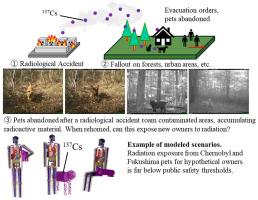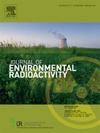估计从切尔诺贝利和福岛获救的狗和猫的潜在收养主人的辐射剂量
IF 2.1
3区 环境科学与生态学
Q3 ENVIRONMENTAL SCIENCES
引用次数: 0
摘要
在切尔诺贝利和福岛第一核电站发生的放射性事故导致大量放射性物质释放到环境中,需要疏散居民。疏散导致许多宠物被非自愿遗弃,在切尔诺贝利和福岛的隔离区仍然可以找到野狗和野猫,可能是留下来的宠物的后代。动物福利组织为这些被遗弃的动物提供照顾,通常是拯救它们,然后帮助它们被收养,或者在某些情况下让它们与原来的主人团聚。然而,这些被遗弃的动物已经适应了一种野生的生活方式,觅食,在这个过程中,体内积累了低水平的放射性,有效地成为辐射源。因此,从切尔诺贝利和福岛获救的狗和猫的收养主人可能会暴露在低水平的辐射中,这可能会阻止一些人考虑收养。利用蒙特卡罗n粒子输运代码对各种宠物主人结合情景进行建模,从而估算出总剂量范围。对几种照射情景中假定所有者所受辐射剂量的评估表明,预期剂量远低于1毫西弗。在保守情况下,受污染的狗或受污染的猫的年有效剂量分别为1.1 × 10 - 3毫西弗和3.6 × 10 - 6毫西弗。这些暴露水平可以忽略不计,因此从剂量角度来看,从这些地区收养猫或狗预计不会造成严重问题。本文章由计算机程序翻译,如有差异,请以英文原文为准。

Estimated radiation doses to potential adoptive-owners of dogs and cats rescued from Chernobyl and Fukushima
The radiological accidents that occurred at the Chernobyl and Fukushima Daiichi nuclear power plants resulted in the release of a substantial amount of radioactive material into the environment, requiring evacuation of residents. Evacuations caused involuntary abandonment of many pets, and both feral dogs and cats can still be found in exclusion zones of Chernobyl and Fukushima, likely offspring of pets left behind. Animal welfare groups have provided care for these forsaken animals, oftentimes rescuing them and subsequently facilitating their adoption, or in some cases reuniting them with their original owners. However, these abandoned animals have adapted to a feral lifestyle, foraging for food and, in the process, accumulating low levels of internal radioactivity, effectively becoming sources of radiation themselves. Consequently, adoptive owners of rescued dogs and cats from Chernobyl and Fukushima may be exposed to low levels of radiation, which could potentially be a deterrent to some considering adoption. Monte Carlo N-Particle transport code was used to model various pet-owner bonding scenarios, enabling the estimation of total dose ranges. Evaluation of radiation doses to hypothetical owners in several exposure scenarios reveals that doses of significantly less than 1 mSv can be expected. Under a conservative scenario, a potential owner would receive an annual effective dose of 1.1 × 10−3 mSv from a contaminated dog or 3.6 × 10−6 mSv from a contaminated cat. These exposure levels are negligible, and thus adopting a cat or dog from these areas is not expected to be a serious concern from a dose perspective.
求助全文
通过发布文献求助,成功后即可免费获取论文全文。
去求助
来源期刊

Journal of environmental radioactivity
环境科学-环境科学
CiteScore
4.70
自引率
13.00%
发文量
209
审稿时长
73 days
期刊介绍:
The Journal of Environmental Radioactivity provides a coherent international forum for publication of original research or review papers on any aspect of the occurrence of radioactivity in natural systems.
Relevant subject areas range from applications of environmental radionuclides as mechanistic or timescale tracers of natural processes to assessments of the radioecological or radiological effects of ambient radioactivity. Papers deal with naturally occurring nuclides or with those created and released by man through nuclear weapons manufacture and testing, energy production, fuel-cycle technology, etc. Reports on radioactivity in the oceans, sediments, rivers, lakes, groundwaters, soils, atmosphere and all divisions of the biosphere are welcomed, but these should not simply be of a monitoring nature unless the data are particularly innovative.
 求助内容:
求助内容: 应助结果提醒方式:
应助结果提醒方式:


